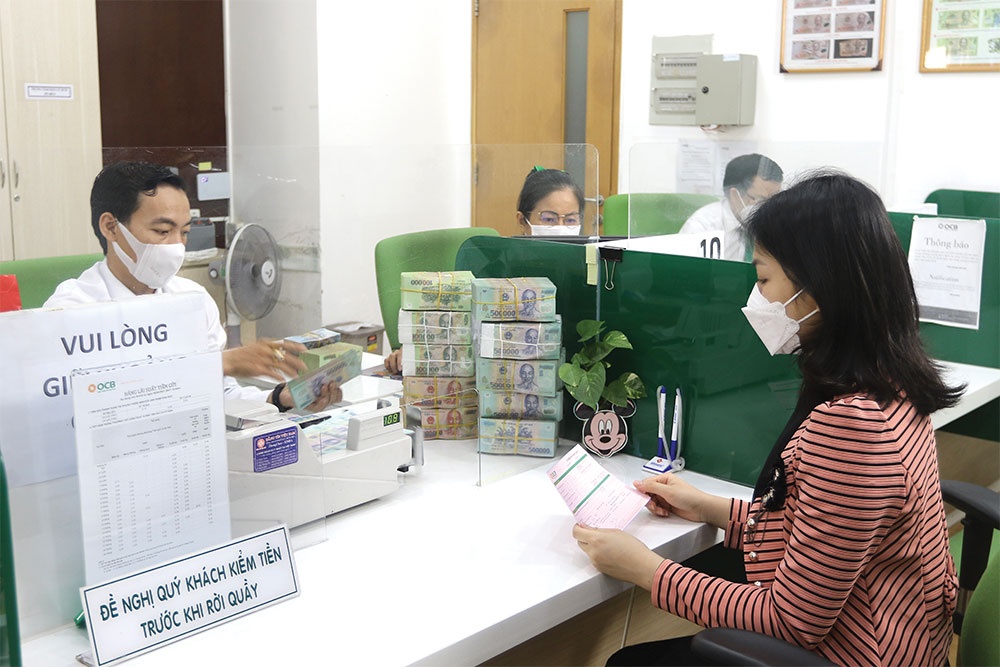Lenders to benefit in SBV debt reposition
 |
| A new circular is helping to bolster bond demand and benefit banks in the market, Photo Le Toan |
The State Bank of Vietnam (SBV) last week issued Circular No.02/2023/TT-NHNN, which regulates the restructuring of repayment terms and the retention of debt groups to support customers in financial difficulty. Of particular note, the provisioning pressure on banks will be reduced as restructured debt will be allocated over 2023 and 2024.
Ha Thu Giang, head of the Credit Department for Economic Sectors under the SBV, stated that Circular 02 targets customers facing difficulties in production and business activities, as well as in repayment of consumer loans. Furthermore, the circular grants credit institutions autonomy in assessing customers’ level of difficulty by examining their revenue and income declines.
Assessing the policy, according to BIDV Securities Company, Circular 02 is more lenient than the previous draft, making it easier for credit institutions to implement and therefore benefiting a wider range of customers. Additionally, the pressure on banks’ profits will be reduced, as banks are still allowed to recognise expected interest income and can spread out provisioning expenses over two years.
Yuanta Securities also emphasises that the policy aims to ease the financial pressure on borrowers in the production and business sectors. However, the quality of assets is a critical issue that needs attention. Reported non-performing loan (NPL) ratios may still be under control under this supportive policy, but financial reports may not fully reflect the impact on asset quality.
On the other hand, SSI Research expressed their concerns, highlighting that Vietnamese banks’ net interest margin (NIM) may face pressure due to the recognition of expected interest income related to restructured loans being denominated in foreign currency.
“From our perspective, banks should be cautious in provisioning, even under this supportive policy, to avoid diminishing asset quality. However, allowing banks to choose to provision for restructured loans over two years will help reduce the impact on profits and capital. The focus should be on asset quality,” stated SSI Research.
The NPL ratio in 2023 may not increase as high as initially estimated, as customers facing difficulties can be considered for debt restructuring. This supportive policy is expected to assist credit institutions in alleviating their borrowers’ financial burden and promote sustainable economic growth. The policy is also advantageous for banks with NPL ratio of nearly 3 per cent.
In addition, as there are no specific regulations regarding the qualified industries for restructuring, SSI believed that loans for certain real estate businesses with incomplete but legally sound projects may be considered for restructuring.
In such cases, as noted by SSI Research, if the developers have the ample financial resources to continue their projects, they may have the opportunity to sell their properties and generate cash flow to cover their debt obligations. This could somewhat alleviate the current liquidity issue for reputable developers. Nevertheless, legal obstacles in the real estate sector remain the main hurdle for the current market situation and cannot be solely addressed through Circular 02.
Furthermore, since the circular also includes consumer loans restructuring, SSI Research expects that some mortgage loans may also be considered for term restructuring.
“Banks that may benefit from Circular 02 are those that have a high lending ratio to real estate developers, such as VPBank, Techcombank, MB, TPBank, and HDBank. We believe that it will also create a legal framework for debt restructuring that may be negatively impacted in the event of a slower-than-expected economic recovery,” commented the brokerage.
Such discerning insights have been echoed by Tran Thi Thu Thao, an analyst of VNDirect.
“Circular 02 will also help bolster bond demand and benefit banks operating strongly in the bond market. However, it depends on risk appetite, especially in the current context where these banks prioritise risk management and balance sheet quality over growth targets,” Thao told VIR.
She further noted that state-owned banks such as Vietcombank, VietinBank, and BIDV stand to benefit if this draft proposal is officially approved.
“This measure could be deemed as a lifeline to fortify the credit growth trajectory of these banking cohorts, especially in the face of an anticipated sharp decrease in NIM. Given the current volatile interest rate landscape, the borrowing rates are anticipated to plummet at a more accelerated pace than the deposit rates, owing to the proactive stance adopted by state-owned banks in minimising lending costs to aid corporate borrowers,” she added.
 | Central bank cuts policy interest rates to spur growth The State Bank of Vietnam (SBV) announced it would reduce several policy interest rates from April 3, the second cut within one month, the regulator announced on its website March 31 night. |
 | Vietnam’s banking system shows signs of money surplus Vietnam’s banking system is showing signs of returning to a period of money surplus as no bank needs the State Bank of Vietnam's (SBV) capital in the open market operation (OMO) channel and overnight interbank interest rates have dropped sharply. |
 | Central bank pushes for rule alignments The State Bank of Vietnam last week sought amendments and supplements to rules relating to the purchase of shares in Vietnamese credit institutions by foreign investors. |
What the stars mean:
★ Poor ★ ★ Promising ★★★ Good ★★★★ Very good ★★★★★ Exceptional
Related Contents
Latest News
More News
- Gold market reform advances as SBV receives applications for bullion production (December 30, 2025 | 12:07)
- EVN and AFD sign credit agreement for Vietnam’s first pumped storage hydropower plant (December 30, 2025 | 10:06)
- Techcombank Priority Visa Signature unlocks a higher standard of living (December 29, 2025 | 16:44)
- Tax sector wraps up 2025 and sets priorities for next year (December 25, 2025 | 14:00)
- A tipping point for digital and hybrid wealth management in Vietnam (December 23, 2025 | 13:33)
- $250 million deal targets women-owned SMEs, sustainable agriculture (December 22, 2025 | 17:40)
- Stock market posts resilient 2025 performance (December 19, 2025 | 18:17)
- Citi Vietnam receives 2025 AmCham CSR recognition (December 19, 2025 | 16:35)
- As global green supply chain reshapes, will Vietnam be left behind? (December 19, 2025 | 08:00)
- Banks gear up for massive capital increases (December 18, 2025 | 17:04)

 Tag:
Tag:





















 Mobile Version
Mobile Version